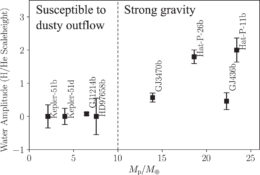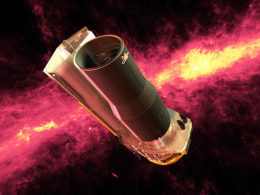Super-puffs — fluffy planets observed to have abnormally low densities — are a problem. According to theoretical models, they shouldn’t exist — and yet we’ve already detected half a dozen of them with Kepler alone. A new study explores what theory might be getting wrong.
A Fluffy Puzzle
Among the assortment of odd and unexpected exoplanets we’ve discovered through years of observing transits, super-puffs stand out as a peculiar puzzle. Super-puffs are planets with masses lower than that of Neptune (< 5 Earth masses), but with sizes equivalent to those of gas-giant planets (transit radii > 5 Earth radii).

Photoevaporation by a planet’s host can boil off the planet’s atmosphere. This process works all the more quickly if the planet doesn’t have strong surface gravity to hold on to its atmosphere. [MPIA]
Piling on further intrigue, transmission spectra of super-puffs show no evident spectral lines. Lines can be washed out by the presence of aerosols — clouds and hazes made up of dust or liquid droplets — but we wouldn’t expect these heavier particles to be able to stay lofted high enough in a fluffy planet’s atmosphere to flatten out its lines.
In a new study, scientists Lile Wang (Flatiron Institute and Princeton University Observatory) and Fei Dai (MIT and Princeton University Observatory) suggest a revamped theoretical model that solves both of these problems.

Spectral strengths of the water feature vs. planet mass. Planets with masses lower than ~10 Earth masses don’t have strong enough gravity to avoid having their spectral features washed out by dusty outflows in the planet atmosphere. [Wang & Dai 2019]
Solutions in Flow
Wang and Dai’s model has a significant change from previous pictures: their proposed atmosphere is not static. Instead, they suggest super-puffs have atmospheres that contain outward flows, continually carrying very small dust grains to high altitudes.
By populating the upper reaches of the atmosphere with dust, these outflows increase the overall opacity of the atmosphere, which prevents it from boiling off quickly. And the dust carried to the upper atmosphere indeed washes out the spectral lines, providing an explanation for the flat spectra we observe.
The authors model one prominent super-puff, Kepler 51b, and show that reasonable outflow rates (a loss of just 10-10 Earth masses of atmosphere per year) can carry dust grains of ~10 Å in size to high altitudes. They show that this process inflates the observed transit radius of the planet to the ~7 Earth radii we see, and it also flattens the planet’s transmission spectra.
Spotting Signs of Dust

The Spitzer Space Telescope could be used to extend the spectral wavelength coverage of planets of interest. Planets with dusty atmospheres would look larger in optical than in infrared wavelengths. [NASA/JPL-Caltech]
This phenomenon has already been observed for several exoplanets, and the authors suggest that we could extend the wavelength coverage for transmission spectra to identify signatures of dusty atmospheres in other planets. Should dusty atmospheres prove common among young, low-mass exoplanets, we clearly will need to reformulate how we think about these bodies.
Citation
“Dusty Outflows in Planetary Atmospheres: Understanding “Super-Puffs” and Transmission Spectra of Sub-Neptunes,” Lile Wang and Fei Dai 2019 ApJL 873 L1. doi:10.3847/2041-8213/ab0653

4 Comments
Pingback: AAS Nova – New
Pingback: Inflating a Super-Puff Planet – readly.info
Pingback: Inflating a Super-Puff Planet - Sky & Telescope - Worldika - New Platform For Explore World
Pingback: Inflating a Super-Puff Planet – Sky & Telescope – AstroBrief